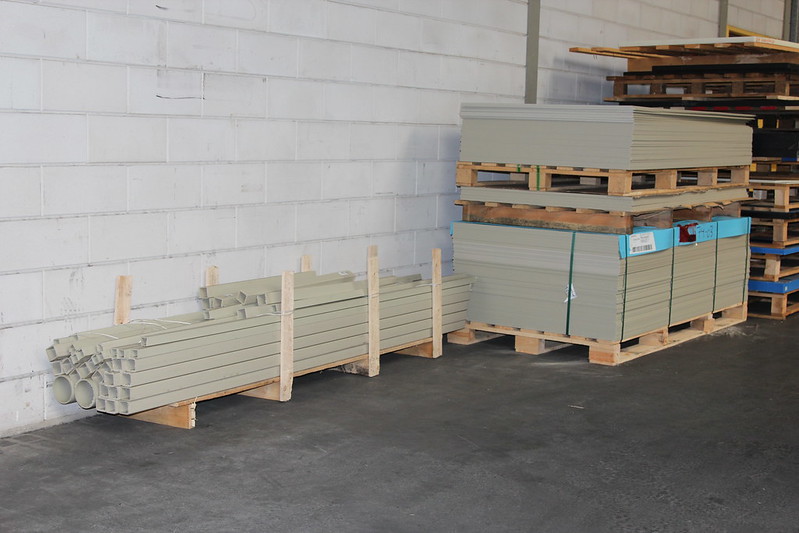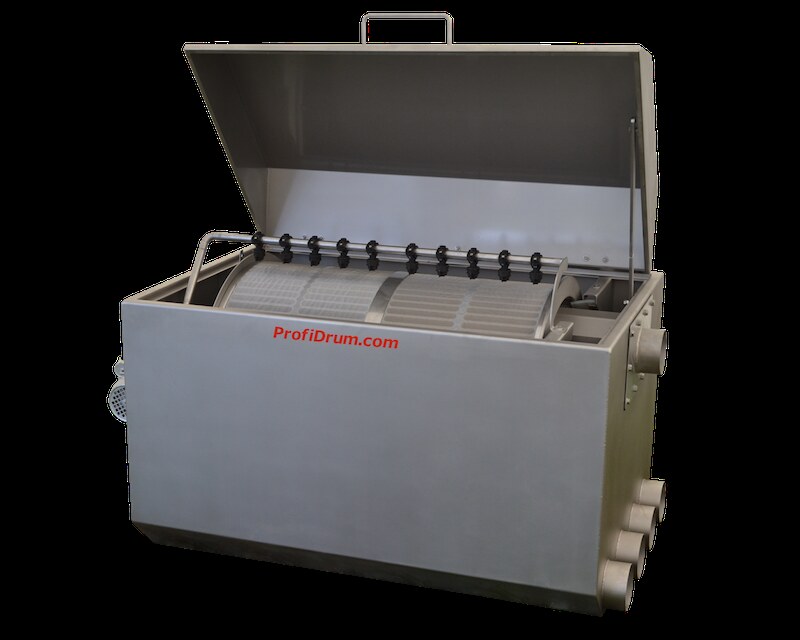I ignited my car and set the navigation on Lopikerkapel, a small town near Utrecht (the Netherlands). I am not going out to seek and see Koi for a change, but I’ll visit a person that made ‘an art’ out of the mechanical pre-filtering of Koi ponds; the drumfilter manufacturer and, since this season, sponsor of KoiQuestion, Jan Hogendoorn.
Nowadays the Koi world cannot be imagined without drumfilters. The principle of a very fine filter cloth, which is automatically cleaned by nozzles when it is about to get clogged and directly disposes the dirt in the sewer, has proven to be a hit in the previous years! This way of pre-filtration allows removal of very small (for Koi ponds down to 40 to 70 micrometres) mechanical dirt from the water, before it passes the biological filter for the removal of dissolved pollution. The system is very easy to maintain.
The company Profidrum was founded about 15 years ago by the hobbyist Jan, who at the time shared his knowledge and vision on Koi forums under the name Jankoi. He wanted to build a good working and maintenance free pre-filter for his own pond. At that time, the concept of the drum filter existed within Germany but it was not yet the ‘ideal pre-filter’ that Jan envisioned. He started with the existing drum filter as an example and after numerous evenings of sketching, designing and building prototypes, the eventual drum filter as we know it was developed.
I will get to see what it takes to make sure that the filter is ‘plug & play’ when it arrives at the customer.
Jan shared his experience with his drum filter on Koi forums, which raised the interest of many hobbyists. It did not take long before the first personal messages came in, with the question if Jan could build his drum filter for others. This was the beginning of Profidrum.
That the company delivers drum filters beyond the use for Koi ponds will become clear to me today. I will follow Jan for a day, to see how the Profidrum filters are produced and for what markets the filters are applied. In addition, I will get to see what it takes to make sure that the filter is ‘plug & play’ when it arrives at the customer. When I arrive at Jan and his wife Ank’s home, I first admire the Koi pond in his garden. Of course this pond is crystal clear, as you can expect from a manufacturer of professional filter systems! The Koi are swimming around calmly while continuously begging for food. They are clearly feeling well!
What I find in the filter house is no surprise to me: a big stainless steel drum filter combined with two bakki showers, also out of stainless steel, from the product line of Profidrum. In combination with a Flowfriend as ‘the beating heart’ this is a simple, but very efficient, way of pond filtration.

After having enjoyed a cup of coffee and discussing the plans for today, we leave for the first address: the manufacturer of the polypropene housing of the ECO-series. Originally, the drum filters were only build from high quality stainless steel (316). But given the high costs of the stainless steel Jan decided to also offer the drum filters with a polypropene housing, so that the price of the filter is more ‘wallet friendly’. Jan stresses that this only concerns the housing! The drum itself and all other components within are always produced with stainless steel, so that the quality is guaranteed. After a short drive we arrive at the first address. All the suppliers are near Jan’s house in Lopikerkapel, so that they are within reach and this eases the control, communication and the adjustment of the production of the filters.
When entering the company, we are welcomed by the business manager and we have a look at the production process. Walking past the assembly department, I easily recognize the housings for the different types of drum filters and the combi-bio filters.

The combi-bio filters are what you can expect from their name, a combination between a drum filter and a moving bed filter. So, a complete filter system within one housing. Together with the business manager we follow the entire production process; we start at the storage room of the polypropene plates. Numerous plates with different thickness, contents and colours are waiting to be processed into semi-finished products and engineering parts.


Hereafter we visit the department where the plates are cut into the exact dimensions, based on a digital CAD-model. Certain parts of the housing have grooves, which are made with the use of a huge milling machine in which full plates are placed. The milling machine is also programmed based on the CAD model, so that it produces ready-to-use parts.


When the plates have the right dimensions and all the parts have the correct grooves, they are transported to the assembly department, where the housings are manually welded and finished. The last part of the production process is the quality control and a test to determine if the housing is waterproof.

At the end of our visit, we lift a big Combi Bio 50 in the van, which has to be delivered at a costumer. Time to go and visit our second address of the day. During the drive we discuss a part of the drum that was invented by Jan: the sealing of the drum. This essential part of the drum filter has to separate the dirty and the clean water compartments, while the drum needs to be able to rotate. This invention of Jan was by accident.
This invention of Jan was by accident…
Experiments with an inflatable rubber band as a seal failed: the rubber band did not remain tense enough, the rubber got loose and slowed down the drum. This was definitely not the solution. The following experiments where with a silicon strip, which Jan mounted to the housing and should ‘slide’ along the flange of the drum. This could have been a break-though!
However, when mounting the drum it became evident that Jan had made a mistake when measuring and sawing the round shape of the drum housing! This appeared a ‘genius mistake’. Because of the somewhat smaller opening of the drum itself, the silicon strip fitted perfectly and closed the opening in such a way that it separated the dirty from the clean water compartment sufficiently and did not restrain the drum. EUREKA! An ideal seal of the drum was born!

Soon we drive our van on to the site of the stainless steel supplier… What we have seen over there, can be read by you in part two of this article.
translation by: Janine Doorduin.








